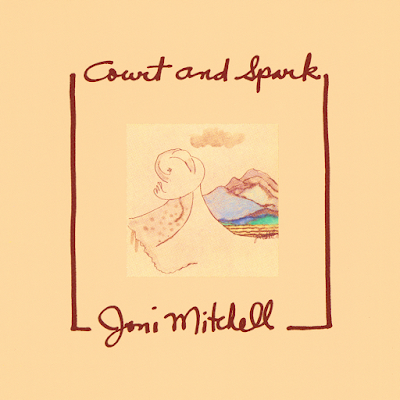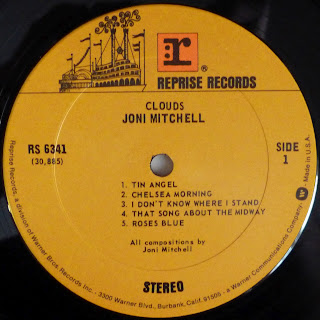 While I collect and listen to just about every kind of music, more than half of the 4,500 albums in my collection are classic rock from the 60s and 70s. It's the music I grew up with, and the music that still resonates must strongly with me. I have at least one copy (and sometimes four or five) of every album made by the Beatles, Beach Boys, Bob Dylan, The Allman Brothers, CSNY, Steely Dan, The Band, The Who, and so on. I also have an extensive collection of albums by great niche artists from the same era, like Tim Buckley, Ry Cooder, Bert Jansch, Judee Sill, Delaney and Bonnie, Roy Buchanan, Captain Beefheart, Nick Drake, Fotheringay, Arlo Guthrie, Tim Harden, Leo Kottke, Love, Tim Moore, Fred Neil, Laura Nyro, Shawn Phillips, Stan Rogers, Valdy, Paul Siebel, Bobby Whitlock, and Claudia Schmidt, just to name a few.
While I collect and listen to just about every kind of music, more than half of the 4,500 albums in my collection are classic rock from the 60s and 70s. It's the music I grew up with, and the music that still resonates must strongly with me. I have at least one copy (and sometimes four or five) of every album made by the Beatles, Beach Boys, Bob Dylan, The Allman Brothers, CSNY, Steely Dan, The Band, The Who, and so on. I also have an extensive collection of albums by great niche artists from the same era, like Tim Buckley, Ry Cooder, Bert Jansch, Judee Sill, Delaney and Bonnie, Roy Buchanan, Captain Beefheart, Nick Drake, Fotheringay, Arlo Guthrie, Tim Harden, Leo Kottke, Love, Tim Moore, Fred Neil, Laura Nyro, Shawn Phillips, Stan Rogers, Valdy, Paul Siebel, Bobby Whitlock, and Claudia Schmidt, just to name a few.I mention all this because it's not all that often that I run across a terrific singer from the 60s or 70s that I've never heard of. And when I do, I always think, "How the heck did I miss this guy?" In the last few weeks I picked up about 50 $1 albums from a couple of different stores. When I'm looking through $1 albums, I'll grab just about anything that isn't beat to crap and looks halfway interesting. Included in this latest haul were a couple of jewels by two singers I don't think I've ever heard of. The first was the 1975 release The Eyes Of An Only Child by Tom Jans.
The copy I found is a promo copy with a DJ strip on the front that lists the tracks. The vinyl is NM, while the jacket is only VG. The cover photo was interesting enough that I would have bought it anyway, but what sold me was seeing in the credits on the back that the great Lowell George wrote one song and produced and played guitar on a couple of others. Among the session musicians on the album are Jeff Porcaro and Jim Keltner on drums, David Lindley and Jesse Ed Davis on guitar, and Bill Paine (of Little Feat) on piano, and Valerie Carter on backing vocals. Good grief, talk about an all-star band! These folks couldn't make a bad album if they tried.
And clearly they didn't. This is a terrific album, Jans' second, recorded at L.A.'s Sunset Sound Studios. I'd classify it as folk/rock or California rock. It has amazing lyrics, great tunes, and incredible playing. Back to the cover photo: It was taken by noted photographer Ethan Russell who also shot the covers for the Beatles' Let It Be and The Who's Quadrophenia, among many others.
According to Discogs, Eyes Of An Only Child has not been reissued on vinyl, and was only issued on CD in Japan. My copy is on a white Columbia promo label with the CBS "eyes" around the rim in black. It was mastered by Artisan Sounds in Hollywood and pressed at Columbia's Santa Maria, CA plant. I'll definitely be keeping an eye out for other albums by Jans.
Behind Door Number 2
The other great find in my $1 album haul is the 1969 release California Bloodlines by singer/songwriter John Stewart. Once again, the style is folk/rock, shading toward country/rock.
If the name John Stewart rings a bell (it didn't with me), it may be because from 1961-67 he was a member of the second iteration of the Kingston Trio. When the Trio disbanded in 1967, Stewart pursued a career as a singer/songwriter. He hit pay dirt almost immediately with his song "Daydream Believer," which The Monkees took to number one on the charts in December of 1967. (No, I did not remember that.) In 1968, while working on Bobby Kennedy's presidential campaign, Stewart met and married folk singer Buffy Ford. They put out one album as a duet before Stewart turned to recording as a solo artist. California Bloodlines was his first solo album.
The album was produced by the legendary Nick Venet, a credit that once again was enough to convince to invest a dollar. Venet was the 21-year-old A&R wunderkind at Capital Records who signed and later produced The Beach Boys, among many other great artists. For California Bloodlines, Venet took Stewart to Nashville to record with some of the city's hottest pickers. In fact, many of the Nashville cats who play on California Bloodlines also show up on Bob Dylan's Nashville Skyline album. In his review of California Bloodlines, music critic Thom Jurek writes that "The songs are romantic visions of people and places that come out of a present which is already in the past and a past inhabited by ghosts. His portraits of spirits are made nearly flesh in his songs, which are ambitious lyrically if not musically."
Yeah, whatever. This is a great, great album. My copy is a genuine NM/NM. It looks like it was never played. It's on the Capitol rainbow label (like the early Beatles albums) and was pressed at Capitol's Los Angeles plant. Once again, I'll be looking for more John Stewart albums in the future.
My advice is to keep your eyes peeled when you're looking through the $1 bins -- and enjoy the music!

















































